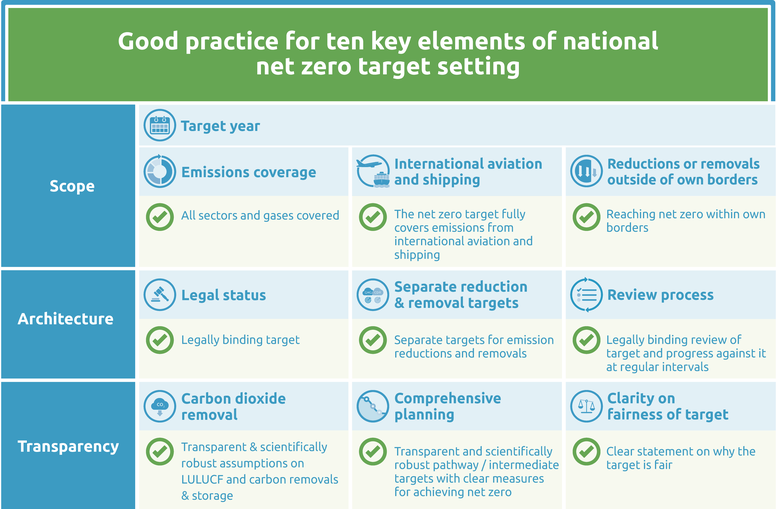Net zero targets
Summary
We evaluate the net zero target as: Acceptable.
Viet Nam announced a target to achieve net zero by 2050 target during the COP26 World Leaders' Summit in 2021. In July 2022, Viet Nam enshrined its net zero target in law. It has also developed a National Climate Change Strategy to guide its planning to achieve the target, which it approved per Decision No.896/QD-TTg. Viet Nam’s net zero target is conditional on the receipt of international financial support.
In the National Climate Change Strategy, the government of Viet Nam sets a cap on total emissions of 185 MtCO2e in 2050. The emissions cap is divided between the energy (101 MtCO2e), industry (20 MtCO2e), agriculture (56 MtCO2e), and waste (8 MtCO2e) sectors. The strategy aims at compensating for the remaining emissions with removals from the land use, land-use change and forestry (LULUCF) sector, as well as an increase in carbon sequestration in the LULUCF sector. It is expected that the combination of these actions will allow Viet Nam to achieve net zero in 2050.
The National Climate Change Strategy calls for a gradual transition from coal-fired electricity to cleaner energy sources, reducing the share of fossil fuel energy sources, not developing new coal-fired power projects after 2030, while gradually reducing coal power capacity after 2035.
Improving energy efficiency is also emphasised in this strategy by increasing the share of energy efficient equipment in use within the industrial, residential and agricultural sectors, including the reduction of fuel use from the electrification of agricultural machinery in the post-harvest agricultural production chain.
CAT analysis of net zero target
Ten key elements
Scope
- Target year – Viet Nam aims to reach net zero by 2050.
- Emissions coverage – Viet Nam’s net zero target covers the three main GHG emissions i.e. CO2 (74%), CH4 (21%), N2O (5%) as these are the relevant gases in Viet Nam. Emissions of F-gases are negligible in Viet Nam. HFCs are <1% (Ministry of Natural Resources and Environment, 2020).
- International aviation and shipping – Viet Nam does not provide information on international aviation and shipping in its targets.
- Reductions or removals outside of own borders – Viet Nam does not provide information on its intention to use international offset credits to meet its net zero target by 2050.
Target architecture
- Legal status – The Vietnamese government has approved its 2050 National Climate Change Strategy and enshrined its net zero target into law (Viet Nam Government, 2022).
- Separate reduction & removal targets – In its National Climate Change Strategy, Viet Nam aims to reduce emissions from the land use, land-use change and forestry (LULUCF) sector by 90% in 2050 relative to the BAU level. In addition, Viet Nam intends to increase carbon sequestration by 30% relative to the BAU level. The combination of actions in the LULUCF and carbon sequestration sectors are expected to provide a 185 MtCO2e sink.
In the National Climate Change Strategy, Viet Nam sets a target to maintain forest coverage at 43% along with ensuring area of national forest, improve forest quality and sustainable forest management (Viet Nam Government, 2022). - Review process – In the National Climate Change Strategy, there are provisions for reviewing and updating national strategies, as well as planning for a 5-year and 10-year period. The reviewing process seeks to balance socio-economic development plans with Viet Nam’s net zero goals, and the Ministry of Planning and Investment will oversee this.
Transparency
- Carbon dioxide removal – Viet Nam has a target to increase its carbon sequestration capacity by 30% compared to its BAU, which is expected to realise a 185 MtCO2e of carbon sink capacity in 2050 when combined with actions in the LULUCF sector.
- Comprehensive planning – In its National Climate Change Strategy, Viet Nam provides detailed sectoral emissions reductions targets for energy, industrial process, agriculture and waste, as well as the LULUCF sector along with sector specific key action areas. This strategy also provides an interim target in 2030 of 36% reduction from BAU level of emissions (excluding LULUCF) in 2030 (977 MtCO2e) and emissions peaking by 2035. The strategy states that Viet Nam will not develop new coal-fired power plants after 2030, and it will gradually reduce its coal fleet after 2035.
- Clarity on fairness of target – Viet Nam provides no information on its intention to explain the target’s fairness.
Good practice
The Climate Action Tracker has defined the following good practice for all ten key elements of net zero targets. Countries can refer to this good practice to design or enhance their net zero targets.
Further analysis
Latest publications
Stay informed
Subscribe to our newsletter





